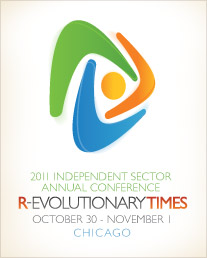It is always fascinating to be in a room full of people focused on changing the issues that plague society. For some it will be improving education, for others it is funding that next great social innovation. For others it may be researching and determining the best way to address a community health crisis. Though their paths may be different, the goal at the end is almost always that we all live in a better world. My takeaway from last week’s Independent Sector (IS) conference is though paths may not always naturally cross, it is expanded connections and networks that will create real social change. Learning from others what works, sharing how collective impact and partnerships can move the needle on social issues, and creating connections across methods in the sector will make a lasting difference.
cross, it is expanded connections and networks that will create real social change. Learning from others what works, sharing how collective impact and partnerships can move the needle on social issues, and creating connections across methods in the sector will make a lasting difference.
Though this was not surprising, and is something that we at the SISGI Group see as core to our work, it was interesting to see how often these ideas of connections/collaborations were shared as a best practice throughout the conference. I have stated previously the difficulty that those of us working on social change experience when trying at times to collaborate with others doing similar or related work. I have often felt, and still believe, that it will be up to the funding community to change the way that individual nonprofit organizations view connections within the sector. For as long as there exists a mechanism for increased competition between similarly focused organizations, there will be limited opportunities for collective impact or collaboration. Many of the funders expressed and provided examples of the ways they are changing their giving from that of forced collaboration and as Howard W. Buffet at the Social Good Summit defined “Philanthropic Colonialism” to a strategy where they are encouraging networked action and grassroots partnerships. This was an encouraging change in the philanthropic landscape.
The highlight of the conference is not necessarily the content shared in workshops or sessions, but in the opportunity to bounce ideas, strategize and network with other  professionals interested in creating change. With the diversity in professional focus, role and organizations it provided a unique opportunity to learn and connect from within the sector. Unfortunately, given the limited budgets for training and professional development within most organizations, attending may not be an option for many nonprofit professionals from smaller organizations located outside of the geographic location of the conference. There is so much to be learned from all segments and sizes of organizations working for change. This lack of opportunity may create a limited discussion/perspective around social problems within the conference. The nonprofit leaders working tirelessly with a very restricted budget and local partners, may not be represented in a community of professionals working in well funded and connected national organizations. As someone who has worked in and with organizations at both ends of the nonprofit spectrum, I see the importance of having both perspectives in all discussions around social change. However, the group that was in attendance at the NGen pre-conference, including the many local individuals working for organizations in the Chicago area, left me inspired and excited about the ways this “Next Generation” are going to lead the sector. This included listening to Ben Rattray of Change.org discussing his frustration with the current methods of investing/philanthropy in this sector vs. the for-profit/venture capital sector during an evening plenary. It also included an opportunity to connect and learn from Robert Briggs of the GAR Foundation and Chairman of the John S. and James L. Knight Foundation during the Ambassador luncheon. The conference was full of opportunities to see and hear different perspectives on social change.
professionals interested in creating change. With the diversity in professional focus, role and organizations it provided a unique opportunity to learn and connect from within the sector. Unfortunately, given the limited budgets for training and professional development within most organizations, attending may not be an option for many nonprofit professionals from smaller organizations located outside of the geographic location of the conference. There is so much to be learned from all segments and sizes of organizations working for change. This lack of opportunity may create a limited discussion/perspective around social problems within the conference. The nonprofit leaders working tirelessly with a very restricted budget and local partners, may not be represented in a community of professionals working in well funded and connected national organizations. As someone who has worked in and with organizations at both ends of the nonprofit spectrum, I see the importance of having both perspectives in all discussions around social change. However, the group that was in attendance at the NGen pre-conference, including the many local individuals working for organizations in the Chicago area, left me inspired and excited about the ways this “Next Generation” are going to lead the sector. This included listening to Ben Rattray of Change.org discussing his frustration with the current methods of investing/philanthropy in this sector vs. the for-profit/venture capital sector during an evening plenary. It also included an opportunity to connect and learn from Robert Briggs of the GAR Foundation and Chairman of the John S. and James L. Knight Foundation during the Ambassador luncheon. The conference was full of opportunities to see and hear different perspectives on social change.
Though this conference is an amazing learning and networking opportunity, it can be a bit out of reach for smaller, underfunded, or under resourced organizations. This is an opportunity for funders, corporate philanthropists, and social change leaders to all be in one place at one time. For funders, it is an opportunity to learn new ways that they can support the sector. For organizations it is an opportunity to engage the funders in this discovery process. Unfortunately, much of the sharing and opportunities are coming from highly resourced organizations that may already have connections to many of the funders in attendance. Rather than creating several new connections, it may just reinforce the existing network connections and some of the inequities of the spread of resources in the sector. For smaller players, whose size are not reflective of their ability to create strong social change strategies, it may be difficult to navigate into the “club”. This is not to say that those at the conference were not open to engaging and meeting with smaller and less resourced organizations, just that many of those organizations were not even in attendance. To create the better world that we all desire, every type of player for change must be at the table. For it may be that small voice for change that inspires and informs the evolution of the sector.
opportunity for funders, corporate philanthropists, and social change leaders to all be in one place at one time. For funders, it is an opportunity to learn new ways that they can support the sector. For organizations it is an opportunity to engage the funders in this discovery process. Unfortunately, much of the sharing and opportunities are coming from highly resourced organizations that may already have connections to many of the funders in attendance. Rather than creating several new connections, it may just reinforce the existing network connections and some of the inequities of the spread of resources in the sector. For smaller players, whose size are not reflective of their ability to create strong social change strategies, it may be difficult to navigate into the “club”. This is not to say that those at the conference were not open to engaging and meeting with smaller and less resourced organizations, just that many of those organizations were not even in attendance. To create the better world that we all desire, every type of player for change must be at the table. For it may be that small voice for change that inspires and informs the evolution of the sector.


